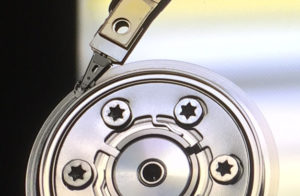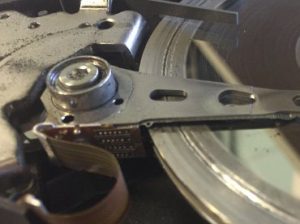
The platters and actuator heads of a hard drive.
Any hard drive can fail, regardless of brand, usage, or other factors. Seagate external hard drives are no different: Even if you’ve used your external drive sparingly — and you’ve maintained excellent operating conditions — failures can occur.
If the data on your external hard drive is important, we strongly recommend working with a professional data recovery provider. Attempting to operate a failed drive can lead to permanent media damage. Generally speaking, you have one chance to recover important data; do-it-yourself data recovery is never a great idea.
Datarecovery.com provides free hard drive evaluations, and our no data, no charge guarantee provides peace of mind: If we’re unable to recover the files you need, there’s no charge for the attempt. Submit a case online or call 1-800-237-4200 to get started.
With that said, some Seagate hard drive issues have nothing to do with the health of the internal drive. Here’s a quick guide for diagnosing failures and troubleshooting.
Seagate External Hard Drives: Basic Troubleshooting
Begin by eliminating the most frequent culprits:
- Verify the Power Source: A loose or faulty power connection can prevent your drive from turning on or being recognized. Ensure the power cord is securely connected to both the drive and a functioning wall outlet. If your drive relies on an external power adapter, confirm it’s the correct voltage and amperage for your model.
- USB Port Functionality: Ports can be surprisingly unreliable, particularly when external drives are fully powered through USB. Test the drive by connecting it to various USB ports on your computer, including those on the back or sides, as they may be connected to different internal controllers. A damaged or malfunctioning port may not provide the necessary power or data connection.
- Cable Integrity: A damaged or faulty USB cable can prevent proper communication between your drive and computer. Swap the cable with a cable that you’ve tested with another device.
After verifying the power, determine whether the hard drive is recognized by your computer.
If the basic checks don’t resolve the issue, we need to delve deeper into your system.
Windows Users:
- Device Manager Inspection: Device Manager provides a comprehensive view of your computer’s hardware. If your Seagate drive isn’t listed under “Disk Drives,” or if it’s marked with a yellow exclamation point, this signals a driver issue or a problem with the drive itself. Error codes found in the drive’s “Properties” (such as Code 10, which often indicates a hardware failure, or Code 28/43, which suggest driver problems) can provide a diagnosis.
- Disk Management Analysis: Disk Management allows you to view and manage the drives connected to your computer. If your Seagate drive appears as “Unallocated” or with a “RAW” file system, this suggests a formatting issue or more serious file system corruption, which may necessitate data recovery software or professional services.
Note that “Code 10″ may be displayed if the drive isn’t receiving sufficient power or the USB cable is faulty. This is why it’s important to verify the power source and cables before troubleshooting.
Mac Users:
- Disk Utility Examination: Disk Utility is a versatile tool for managing drives on macOS. If your Seagate drive isn’t visible in Disk Utility, it’s not being recognized by the operating system, potentially due to connection problems, drive failure, or macOS-specific compatibility issues.
- System Information Review: System Information provides a detailed overview of your Mac’s hardware and software. Checking the “USB” section (or the relevant interface) can help identify whether the system is detecting the drive at all, which can help narrow down the problem.
Code 28 on Seagate External Hard Drive
Code 28 and Code 43 can indicate driver problems. Trying the drive on another computer should resolve the issue. If you can verify that the drive is functional with another machine, you can try the following steps to reload the drivers:
- Close the Device Manager window.
- Right-click on the problematic device and select “Uninstall.”
- Shut down your computer and disconnect the Seagate drive.
- Reboot your computer without the drive connected.
- Once the computer has fully booted, plug the drive into a different USB port.
- Windows should automatically detect the drive and start installing the necessary device drivers.
- After the driver installation is complete, check Device Manager again to see if the error code has been resolved.
This process essentially forces Windows to reinstall the drivers for the Seagate drive, which can sometimes resolve corruption or compatibility issues.
The Risks of DIY Data Recovery

A hard drive’s platters with severe damage.
Attempting data recovery without the proper knowledge and tools can be risky. If your drive has suffered a head crash (where the read/write heads contact the disk platters), any further operation can cause irreparable damage and permanent data loss.
If your drive is functional and you intend to use data recovery software, read about the risks. Before running any software, make a clone of your drive, then run the software on the clone (not on the original drive).
Here are a few resources to bookmark:
Datarecovery.com provides free evaluations and a no data, no charge guarantee.
Datarecovery.com offers a no data, no charge policy for all hard drive failure scenarios, which provides peace of mind as your case progresses. Each of our full-service laboratories is outfitted with industry-leading technology to ensure high success rates, low recovery costs, and fast turnaround times.
Each case begins with a risk-free evaluation. Contact us today at 1-800-237-4200 or fill out our online case form to get started.




